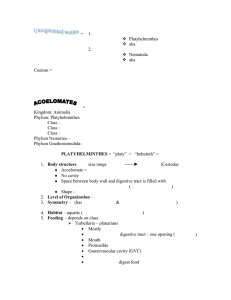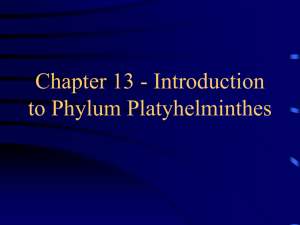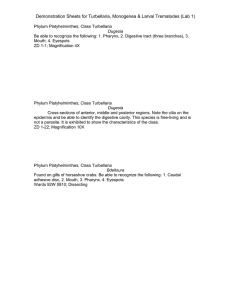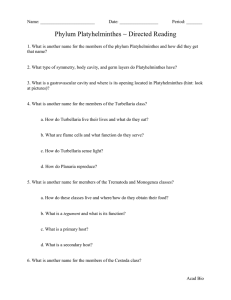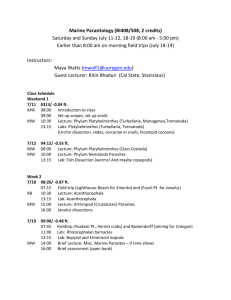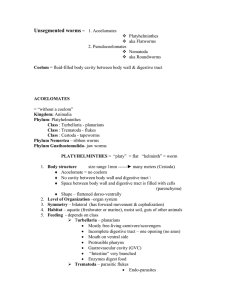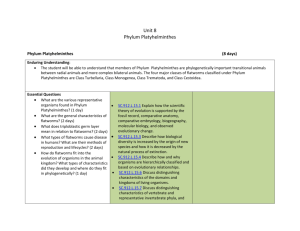Demonstration Sheets for Adult Trematodes (Lab 2)
advertisement
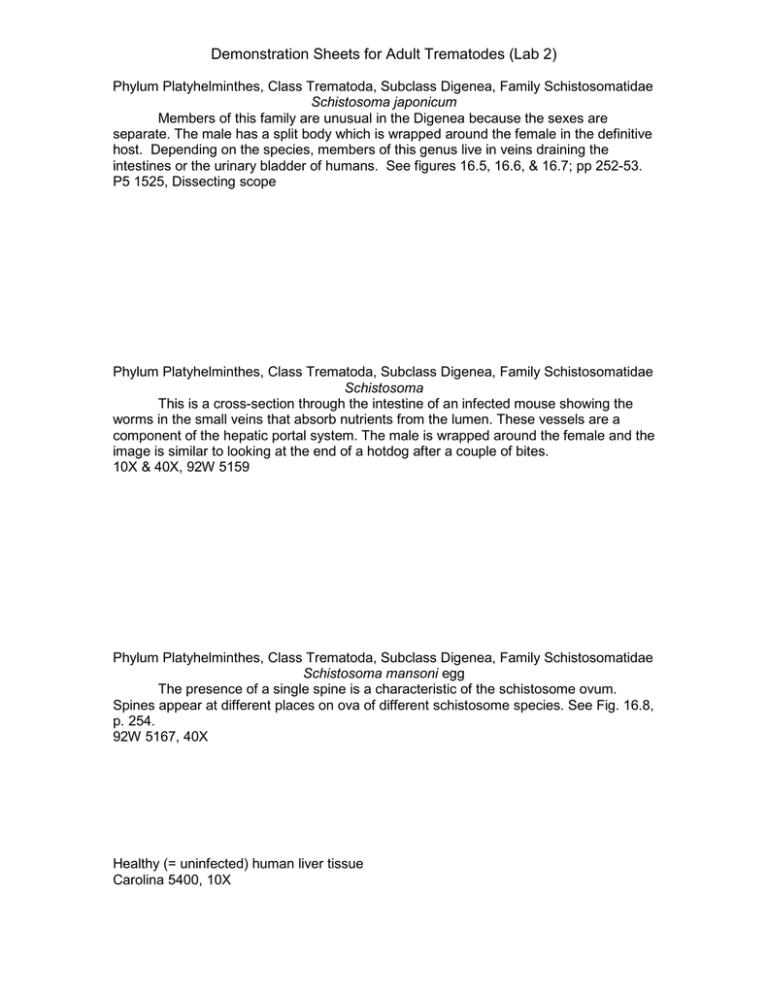
Demonstration Sheets for Adult Trematodes (Lab 2) Phylum Platyhelminthes, Class Trematoda, Subclass Digenea, Family Schistosomatidae Schistosoma japonicum Members of this family are unusual in the Digenea because the sexes are separate. The male has a split body which is wrapped around the female in the definitive host. Depending on the species, members of this genus live in veins draining the intestines or the urinary bladder of humans. See figures 16.5, 16.6, & 16.7; pp 252-53. P5 1525, Dissecting scope Phylum Platyhelminthes, Class Trematoda, Subclass Digenea, Family Schistosomatidae Schistosoma This is a cross-section through the intestine of an infected mouse showing the worms in the small veins that absorb nutrients from the lumen. These vessels are a component of the hepatic portal system. The male is wrapped around the female and the image is similar to looking at the end of a hotdog after a couple of bites. 10X & 40X, 92W 5159 Phylum Platyhelminthes, Class Trematoda, Subclass Digenea, Family Schistosomatidae Schistosoma mansoni egg The presence of a single spine is a characteristic of the schistosome ovum. Spines appear at different places on ova of different schistosome species. See Fig. 16.8, p. 254. 92W 5167, 40X Healthy (= uninfected) human liver tissue Carolina 5400, 10X Phylum Platyhelminthes, Class Trematoda, Subclass Digenea, Family Schistosomatidae Schistosoma mansoni Eggs in liver are being destroyed by host leukocytes. The immune system forms a granuloma (visible on slide as a ring) around the egg. In some victims the granulomas develop to the point where they restrict blood flow through the liver. In extreme cases, the eggs pass through the liver and lodge in the lungs. See Figures 3.8 (p. 35) and 16.15 & 16.16 (pp. 258- 59) PS 1308, 10X-40X Phylum Platyhelminthes, Class Trematoda, Subclass Digenea Fasciola Sheep liver fluke. Adults are found in bile ducts of humans and herbivores. Infective metacercariae are found on leaves of plants. Figs. 17.4 & 17.5 (pp 268 & 270) Specimen and slides (= PS 1250), No scope Phylum Platyhelminthes, Class Trematoda, Subclass Digenea Paragonimus westermani Lung fluke Adults of this genus are found in the lungs of carnivores including humans and cats. Ova are carried out of the lungs by cilia on the epithelial cells lining the trachea. The ova are swallowed when they reach the pharynx, pass through the gut, and are voided in host feces. Acquired by eating uncooked crustaceans. See Figs. 18.7 & 18.8 (pp. 281-282) Specimen & slide (= 92W PS 1414), Dissecting Phylum Platyhelminthes, Class Trematoda, Subclass Digenea Dicrocoelium See Figs. 18.1 & 18.2 (pp. 278-79), Be able to identify: 1. Testes (purple stain, large), 2. Ovaries (purple stain, small), 3. Uterus (black), 4. Acetabulum, 5. Oral sucker Tropical Biological, Dissecting Phylum Platyhelminthes, Class Trematoda, Subclass Digenea Eurytrema Genus occurs in the pancreas of raccoons and domestic animals. Insects such as grasshoppers serve as second intermediate hosts. “Dr” Hulda Clarke makes the following claims about this trematode: 1. Causes diabetes, 2. Epstein-Barre virus comes from the fluke. 3. Drinks with wood alcohol enable the fluke access to the pancreas. 4. The fluke can enter the uterine wall and cause endometriosis. Carolina 30-6388 (PS1340), Dissecting Phylum Platyhelminthes, Class Trematoda, Subclass Digenea Trematode Model Use Fig. 18.18 (pp. 287) for help in identifying: Oral sucker, Pharynx, Intestine, Acetabulum, Vitellaria or yolk gland, Uterus, Ovary, Testes, Excretory bladder Phylum Platyhelminthes, Class Trematoda, Subclass Digenea Clonorchis sinensis Chinese liver fluke. Same species as the one on the model. Very common in rural Asian communities. Acquired by eating raw freshwater fish, especially carp. Z950, 4X Phylum Platyhelminthes, Class Trematoda, Subclass Digenea Nasitrema This genus is found in the nasal cavities of whales and dolphins. These specimens were taken from a female bottlenose dolphin that was found dead in Mobile Bay. The presence of parasites in beached marine mammals does not mean that the death or the beaching behavior was caused by the parasite. Specimen, Dissecting Phylum Platyhelminthes, Class Trematoda, Subclass Digenea Hirudinella ventricosa Collected from the stomach of a wahoo (a bluewater game fish) caught during the Dauphin Island Fish Rodeo. For reasons unknown, usually two and only two worms are found in the stomachs of wahoos. Specimen, No scope
